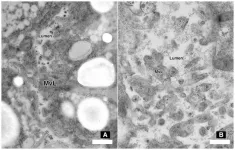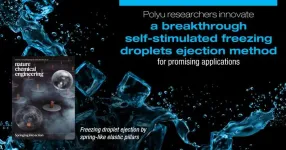(Press-News.org) The microscopic soybean cyst nematode (SCN) may be small, but it has a massive impact. This pest latches onto soybean roots, feeding on their nutrients and leaving a trail of destruction that costs farmers billions in yield losses each year. Unfortunately, current methods to combat SCN are faltering as the pest grows resistant to traditional controls. But new research is now offering a glimmer of hope.
A collaborative team of scientists from BASF Agricultural Solutions and the Advanced Bioimaging Laboratory at the Donald Danforth Plant Science Center are working on a potential solution: a special protein known as Cry14. Published in the journal Molecular Plant-Microbe Interactions (MPMI), this innovative study details how Cry14 could revolutionize the fight against SCN. Lead author R. Howard Berg and his team have developed a way to genetically equip soybean plants with this special protein. This approach, long used in other crops such as corn and cotton to combat insect pests, has now been implemented successfully to prevent SCN from feeding on soybean roots.
This study addresses key scientific questions about the Cry14 protein, including its function and its potential to enhance existing agricultural products for farmers. The study demonstrates that combining Cry14 with current treatment options reduces the SCN population in soybean roots, ultimately leading to higher soybean yields. The research team also investigated how Cry14 provides this protection. Conflicting data in the scientific literature have raised questions about what size is “too large” for SCN to ingest. The Cry14 protein exceeds the previously assumed size limit. However, using state-of-the-art electron microscopy and imaging equipment, the team captured groundbreaking images of the Cry14 protein inside the guts of SCNs feeding on soybean plants expressing the protein. These images provide direct evidence that Cry14 can be ingested by nematodes.
And for the first time, high-resolution electron microscopy was used to document Cry-induced damage, revealing membrane lysis in intestinal cells, which leads to cell death. This finding confirms the expected mode of action for Cry proteins.
This groundbreaking research creates a path for the use of other Cry proteins to control SCN and other nematodes. Until now, conflicting literature and challenges working with Cry proteins had all but closed the door on this as a viable approach for nematode control in plants.
This technology comes along at a critical time: when SCN is developing resistance to control by native soybean traits. The new cell biology information on how Cry14 affects the intestine could stimulate other researchers to apply this technology in novel ways.
For additional details, read “Immunolocalization and ultrastructure show ingestion of Cry protein expressed in Glycine max by Heterodera glycines and its mode of action,” published in MPMI.
About Molecular Plant-Microbe Interactions (MPMI)
Molecular Plant-Microbe Interactions® (MPMI) publishes peer-reviewed fundamental and advanced applied research on the genetics, genomics, molecular biology, biochemistry, and biophysics of pathological, symbiotic, and associative interactions of microbes, insects, nematodes, or parasitic plants with plants.
Follow MPMI on X and Bluesky and visit https://apsjournals.apsnet.org/journal/mpmi to learn more.
END
Harnessing nature to defend soybean roots
Using novel Cry protein to control the number-one soybean pest
2025-01-14
ELSE PRESS RELEASES FROM THIS DATE:
Yes, college students gain holiday weight too—but in the form of muscle not fat
2025-01-14
With the holidays behind us, many Americans are seeing the numbers on the scale go up a pound or two. In fact, data shows that many American midlife and older adults gain 1 to 1.5 pounds over the November through January holiday period. Though not harmful on its own, even a small amount of holiday weight gain in the form of fat can negatively affect health. People often fail to lose the extra weight, which leads to significant cumulative weight gain over the years and contributes to health concerns.
Based on new research, we now know that college students gain the same amount of weight as older ...
Beach guardians: How hidden microbes protect coastal waters in a changing climate
2025-01-14
A hidden world teeming with life lies below beach sands. New Stanford-led research sheds light on how microbial communities in coastal groundwater respond to infiltrating seawater. The study, published Dec. 22 in Environmental Microbiology, reveals the diversity of microbial life inhabiting these critical ecosystems and what might happen if they are inundated by rising seas.
“Beaches can act as a filter between land and sea, processing groundwater and associated chemicals before they reach the ocean,” said study co-first author Jessica Bullington, a Ph.D. student in Earth system science in the Stanford Doerr School of Sustainability. “Understanding ...
Rice researchers unlock new insights into tellurene, paving the way for next-gen electronics
2025-01-14
HOUSTON – (Jan. 14, 2025) – To describe how matter works at infinitesimal scales, researchers designate collective behaviors with single concepts ⎯ like calling a group of birds flying in sync a “flock” or “murmuration.” Known as quasiparticles, the phenomena these concepts refer to could be the key to next-generation technologies.
In a recent study published in Science Advances, a team of researchers led by Shengxi Huang, associate professor of electrical and computer engineering and materials science and nanoengineering at Rice, describe how one such type of quasiparticle ⎯ polarons ⎯ behaves in tellurene, a nanomaterial first synthesized ...
New potential treatment for inherited blinding disease retinitis pigmentosa
2025-01-14
Two new compounds may be able to treat retinitis pigmentosa, a group of inherited eye diseases that cause blindness. The compounds, described in a study published January 14th in the open-access journal PLOS Biology by Beata Jastrzebska from Case Western Reserve University, US, and colleagues, were identified using a virtual screening approach.
In retinitis pigmentosa, the retina protein rhodopsin is often misfolded due to genetic mutations, causing retinal cells to die off and leading to progressive blindness. Small molecules to correct rhodopsin folding are urgently needed to treat the estimated 100,000 ...
Following a 2005 policy, episiotomy rates have reduced in France without an overall increase in anal sphincter injuries during labor, with more research needed to confirm the safest rate of episiotomi
2025-01-14
Following a 2005 policy, episiotomy rates have reduced in France without an overall increase in anal sphincter injuries during labor, with more research needed to confirm the safest rate of episiotomies and the risks to specific subgroups
In your coverage, please use this URL to provide access to the freely available paper in PLOS Medicine: http://journals.plos.org/plosmedicine/article?id=10.1371/journal.pmed.1004501
Article title: Episiotomies and obstetric anal sphincter injuries following a restrictive episiotomy policy in France: An analysis of the 2010, 2016, and 2021 National Perinatal Surveys
Author countries: France, Switzerland
Funding: ...
Rats anticipate location of food-guarding robots when foraging
2025-01-14
Researchers find that rats create neurological maps of places to avoid after experiencing a threat and think about these locations when exhibiting worry-related behaviors. These findings—which A. David Redish of the University of Minnesota, US, and colleagues presented in the open-access journal PLOS Biology on January 14th—may provide insight into the neuroscience of common psychological conditions like anxiety.
There are many theories as to why people experience anxiety. One is that anxiety is associated with a psychological phenomenon called “approach-avoidance conflict,” where ...
The American Association for Anatomy announces their Highest Distinctions of 2025
2025-01-14
ROCKVILLE, MD—January 14, 2025—The American Association for Anatomy (AAA) is thrilled to announce the recipients of their 2025 Spring Awards. Each awardee will be formally recognized at the Anatomy Connected 2025 Closing Awards Ceremony on March 31, in Portland, Oregon.
The Spring Awards include the three highest distinctions awarded by AAA: the Henry Gray Scientific Award, the A.J. Ladman Exemplary Service Award, and the Henry Gray Distinguished Educator Award. The winners of these awards, along with the others on this list, are gathered through a nomination process conducted by their peers ...
Diving deep into dopamine
2025-01-14
Positive feedback is helpful for learning, but usually, our greatest lessons actually come from failure— and a new project at the University of Pittsburgh aims to uncover the neural mechanisms behind this phenomenon.
Helen Schwerdt, assistant professor of bioengineering at Pitt’s Swanson School of Engineering, received a five-year, $2.5 million R01 award from the National Institutes of Health (NIH) to study dopamine’s role in learning. Schwerdt’s team develops novel multimodal neural interfaces ...
Automatic speech recognition on par with humans in noisy conditions
2025-01-14
Automatic speech recognition (ASR) has made incredible advances in the past few years, especially for widely spoken languages such as English. Prior to 2020, it was typically assumed that human abilities for speech recognition far exceeded automatic systems, yet some current systems have started to match human performance. The goal in developing ASR systems has always been to lower the error rate, regardless of how people perform in the same environment. After all, not even people will recognize speech with 100% accuracy in a noisy environment.
In a new study, UZH computational linguistics specialist Eleanor Chodroff and a fellow researcher from Cambridge ...
PolyU researchers develop breakthrough method for self-stimulated ejection of freezing droplets, unlocking cost-effective applications in de-icing
2025-01-14
Water droplets under freezing conditions do not spontaneously detach from surfaces as they do at room temperature due to stronger droplet-surface interaction and lack of an energy transformation pathway. Since accumulated droplets or ice have to be removed manually or with mechanical equipment, which is costly and inefficient, preventing droplet accretion on surfaces is both scientifically intriguing and practically important. Researchers at The Hong Kong Polytechnic University (PolyU) have invented a ground-breaking self-powered mechanism of freezing droplet ejection that allows droplets to ...
LAST 30 PRESS RELEASES:
Bacteria resisting viral infection can still sink carbon to ocean floor
Younger biological age may increase depression risk in older women during COVID-19
Bharat Innovates 2026 National Basecamp Showcases India’s Most Promising Deep-Tech Ventures
Here’s what determines whether your income level rises or falls
SCIE indexation achievement: Celebrate with Space: Science & Technology
Children’s Hospital Colorado performs region’s first pediatric heart and liver dual organ transplant
Australian team discover why quantum computers have memory problems over time
What determines the fate of a T cell?
Candida auris: genetic process revealed which could be treatment target for deadly fungal disease
Groundbreaking discovery turns household plastic recycling into anti-cancer medication
Blocking a key inflammatory pathway improves liver structure and vascular function in cirrhosis, study finds
Continuous spread: Raccoon roundworm detected in nine European countries
HKUST Engineering researchers developed a novel photodetector to enhance the performance of on-chip light monitoring
Strategic river sensors could have forewarned of Texas Camp flood disaster
Drone sampling of whale breath reveals first evidence of potentially deadly virus in Arctic
Roman soldiers defending Hadrian’s Wall infected by parasites, study finds
Pinochet’s prisoners were tormented with music but still found solace in it, a new book reveals
Fertility remains high in rural Tanzania despite access to family planning
AI-assisted device can improve autism care access
Kinetic careers
Uncovering how parasitic plants avoid attacking themselves to improve crop resistance
Nanoparticle vaccine strategy could protect against Ebola and other deadly filoviruses
Study finds brain care score can predict risk of stroke across racial groups
Key lung immune cells can intensify allergic reactions
Do hormones explain why women experience more gut pain?
New materials conduct ions in solids as easily as in liquids
Breakthrough of the Year: Renewable energy begins to eclipse fossil fuel-based sources
LLM use is reshaping scientific enterprise by increasing output, reducing quality and more
Introducing LightGen, a chip for ultra-fast, ultra-efficient generative AI
Astronomers see fireworks from violent collisions around nearby star
[Press-News.org] Harnessing nature to defend soybean rootsUsing novel Cry protein to control the number-one soybean pest







